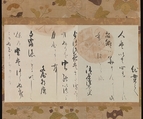Returned to lender The Met accepts temporary loans of art both for short-term exhibitions and for long-term display in its galleries.
Section of a Poem Scroll with Underpainting of Lotus
Calligrapher Hon'ami Kōetsu Japanese
Underpainting by Tawaraya Sōtatsu Japanese
Not on view
Kōetsu’s innovative calligraphic style is celebrated for the way in which it plays with a reader’s expectations. Sometimes he inscribes kana characters in complex archaic forms so that they resemble kanji (Chinese characters); other times, he renders kanji in such an abbreviated and delicate manner that at first glance they resemble kana. A characteristic of his handwriting is the sudden and conspicuous variations in widths of strokes (which, according to orthodox brush styles, would usually be more modulated). Kōetsu was also a master of the art of “scattered writing” (chirashigaki) in which columns of text were rendered in varying lengths to create an attractive arrangement on the page.
This work originally was part of a much longer handscroll and has been remounted as a hanging scroll. The three waka (thirty-one-syllable court verse) are from the famous anthology One Hundred Poems by One Hundred Poets (Hyakunin isshu), compiled by Fujiwara no Teika in the early thirteenth century as a guide to poetry composition.
The poems read, from right to left, as follows:
Hito wa isa
kokoro mo shirazu
furusato wa
hana zo mukashi no
ka ni nioikeru
Though people’s feelings
may have changed,
in this place from my past,
the plum blossoms
still have the scent of long ago.
[signed] Ki no Tsurayuki (ca. 872–945)
Natsu no yo wa
mada yoi nagara
akenuru o
kumo no izuko ni
tsuki yadoruramu
While evening lingers on
this summer night,
dawn has already arrived—
where, amid the clouds,
could the moon be hiding?
[signed] Kiyowara no Fukayabu (active early 10th century)
Shiratsuyu no
kaze ni fukeishiku
aki no no wa
tsuranuki tomenu
tama zo chirikeru
Glistening drops of dew,
scattered by the wind
across autumn plains,
appear like unstrung jewels
scattered everywhere.
[signed] Fun’ya no Asayasu (active late 9th century)
—Trans. John T. Carpenter
Due to rights restrictions, this image cannot be enlarged, viewed at full screen, or downloaded.
This artwork is meant to be viewed from right to left. Scroll left to view more.



